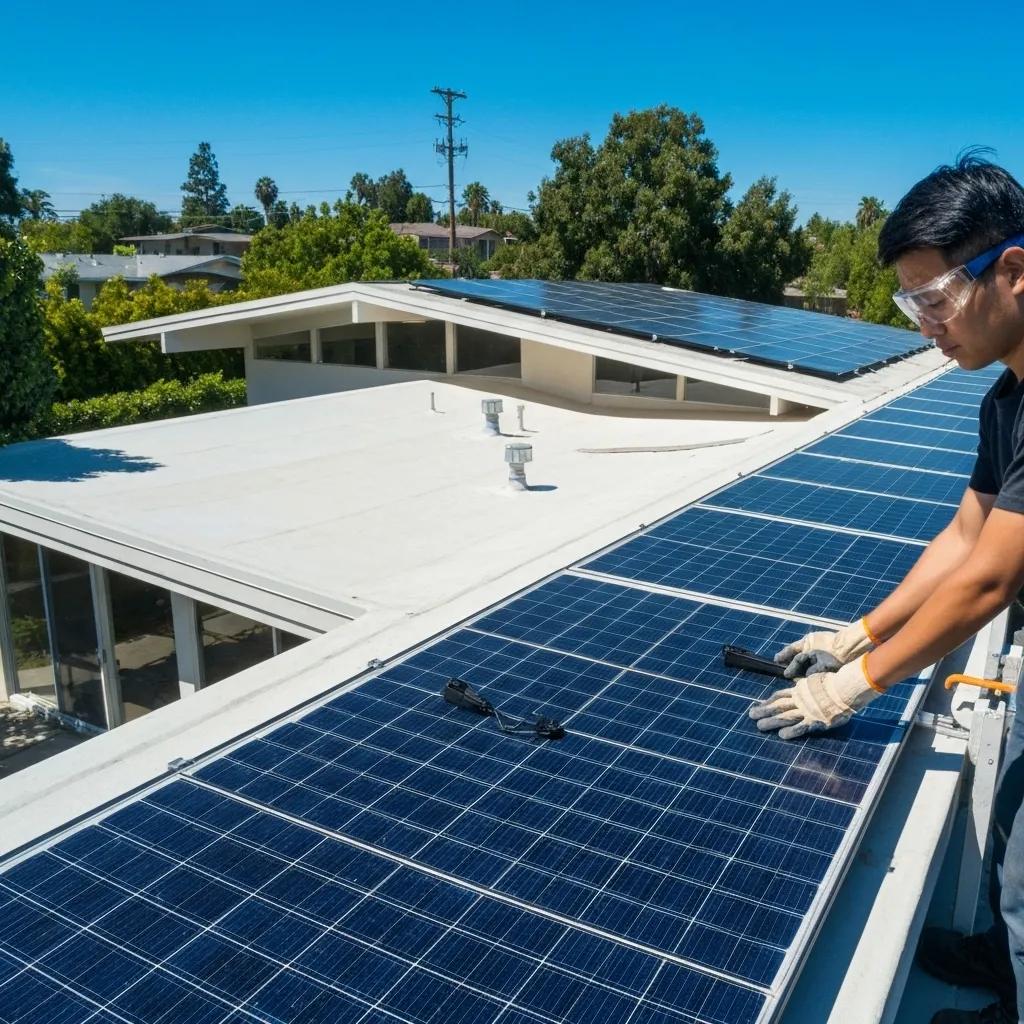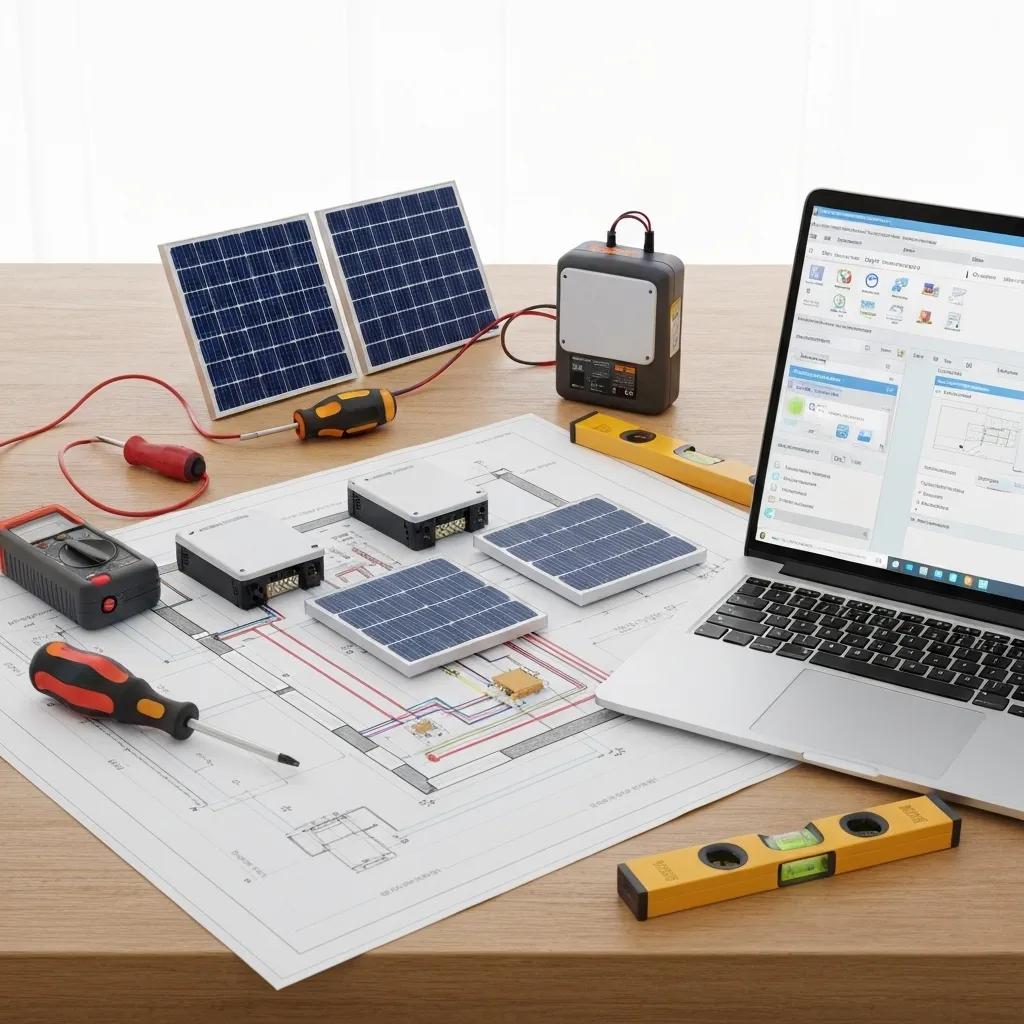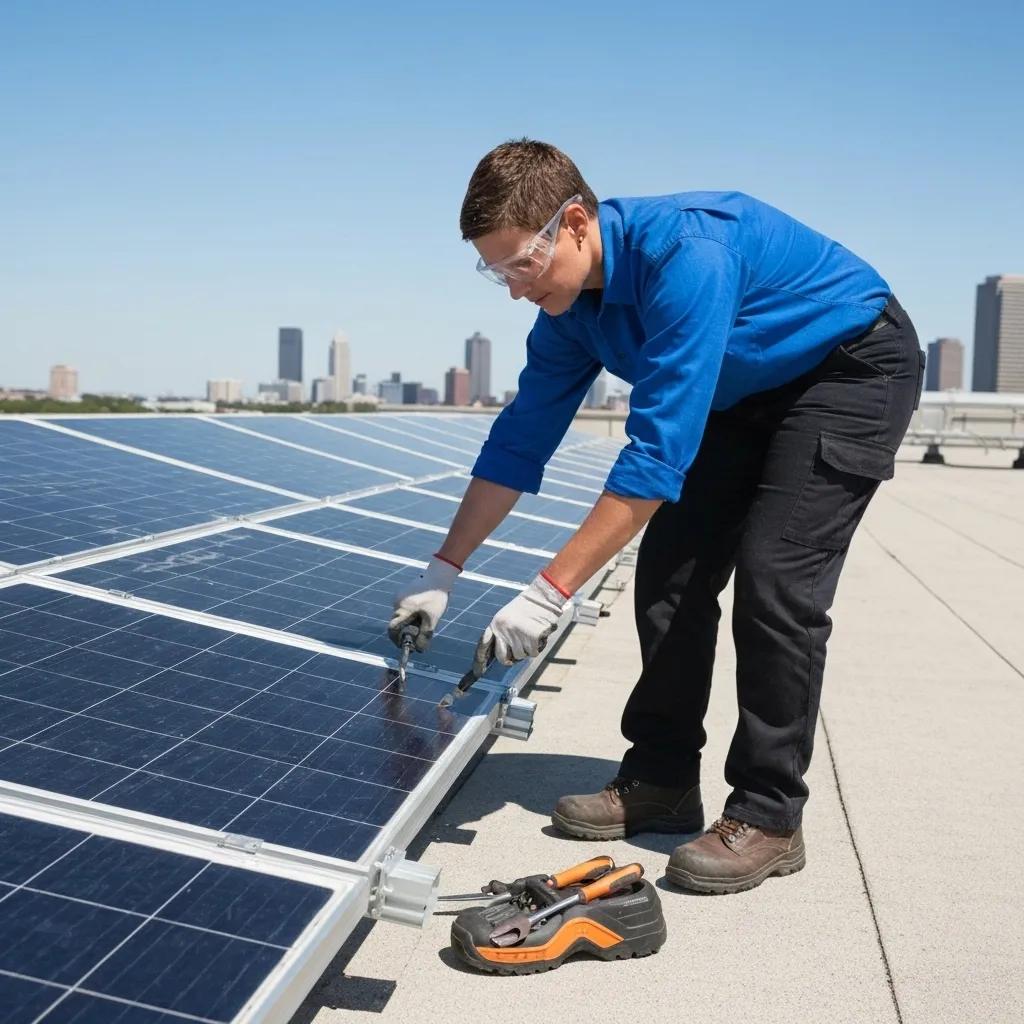Vegas Solar: Las Vegas Solar Panel Installation Experts

Solar Panel Installation and Construction: Complete Guide to Costs, Process, and Solutions
Harnessing solar energy transforms sunlight into long-term savings, increased property value, and reduced carbon footprint. This complete guide to solar panel installation and construction delivers actionable insights on every critical phase: from site assessment and system design to permitting, grid connection, cost breakdowns, component selection, residential vs. commercial strategies, environmental and financial benefits, financing solutions, and ongoing maintenance. You’ll learn how to plan, budget, and optimize a photovoltaic system that meets energy needs and regulatory requirements while maximizing return on investment.
What Are the Key Steps in the Solar Panel Installation Process?
A successful solar installation combines precise evaluation, thoughtful design, compliant permitting, expert installation, and seamless grid integration to generate reliable renewable energy and financial returns.
How Is a Solar Site Assessment Conducted?
A solar site assessment gauges roof orientation, tilt, shading, structural capacity, and household or business energy consumption to determine optimal panel layout and expected output.
- Inspect roof bearing capacity, material condition, and fire rating.
- Perform shading analysis at different times of day and year.
- Review historical energy usage and select target offset percentage.
- Map roof azimuth and tilt angle for maximum irradiance.
Each assessment factor feeds into system design, ensuring panels deliver predicted yields under local climate conditions.
What Does Solar System Design Involve?

Solar system design integrates panel layout, inverter selection, wiring topology, and mounting structure to balance efficiency, cost, and aesthetics.
- Layout Planning – Position panels to avoid shading and maximize sun exposure.
- Component Selection – Choose panel type, inverter model, and racking system.
- Electrical Design – Size DC strings, AC circuits, rapid-shutdown gear, and disconnects.
- Structural Engineering – Verify roof or ground-mount supports meet wind and snow loads.
Coupling optimized electrical and structural design ensures reliable generation, paving the way for permitting.
How Are Permits and Approvals Managed for Installation?
Obtaining local permits and utility approvals ensures compliance with building codes, electrical standards, and interconnection requirements.
- Submit engineered plans and equipment specs to building department.
- Coordinate with utility for interconnection agreement and net-metering eligibility.
- Schedule inspections for structural, electrical, and fire safety.
- Resolve any code corrections and secure final sign-off.
Securing approvals prevents costly delays and guarantees safe, code-compliant operation.
What Are the Typical Installation and Commissioning Steps?
Installation and commissioning follow a systematic sequence that adheres to safety and quality standards.
- Mount racking system and secure attachments.
- Install photovoltaic panels on racks or rails.
- Run DC wiring and connect to inverter or combiner box.
- Mount inverter(s), rapid-shutdown devices, and AC disconnect.
- Perform electrical testing: insulation resistance, polarity checks, and system energization.
- Commission system with utility and record performance metrics.
Thorough commissioning verifies design assumptions and ensures panels perform per specifications.
How Is the Solar System Connected to the Grid?
Grid connection links AC output to the utility network via a bi-directional meter and safety disconnects, enabling net metering and energy crediting.
System output passes through the inverter to produce grid-synchronized AC power → flows through a dedicated breaker in the main panel → utility-grade meter tracks export vs. import → net energy credits reduce future bills.
This integration secures financial benefits and emergency backup options when paired with storage.
How Much Does Solar Panel Installation Cost for Residential and Commercial Projects?
Installation costs depend on system size, project complexity, location, and equipment quality, with residential projects averaging $15,000–$30,000 and commercial installations ranging from $100,000 to $200,000 or more.
U.S. Department of Energy, “Solar Energy Technologies Office” (2024)
Solar Panel Installation Costs and Factors – English
The cost of solar panel installation varies based on system size, project complexity, location, and equipment quality. Residential projects typically range from $15,000 to $30,000, while commercial installations can range from $100,000 to $200,000 or more.
What Factors Influence Residential Solar Installation Costs?
Residential costs hinge on:
- System Size – Larger arrays increase panels, inverters, and labor.
- Panel Type – High-efficiency modules command premium prices.
- Roof Complexity – Multiple roof planes or steep pitches require extra labor.
- Local Labor Rates – Regional contractor rates vary widely.
- Permitting and Utility Fees – Municipality and interconnection charges.
Understanding these factors helps homeowners budget accurately and select optimal solutions.
How Do Commercial Solar Construction Costs Differ?
Commercial solar projects scale with:
- Array Footprint – Roof or ground area requirements.
- Structural Upgrades – Reinforced roofing or ground-mount foundations.
- Electrical Infrastructure – Three-phase connections, larger switchgear, and transformer needs.
- Design Complexity – Custom layouts to integrate with facility operations.
- Permitting and Inspections – Additional zoning, fire marshal, and utility requirements.
Scale economies often reduce per-watt costs, but complexity can offset savings.
What Are the Average Price Ranges and Cost Breakdown?
Below is a typical cost breakdown for residential vs. commercial systems.
Equipment dominates residential expenses, while soft costs and permitting rise for larger commercial arrays.
How Can Financing Options Reduce Upfront Costs?
Homeowners and businesses can leverage:
- Solar Loans – Low-interest financing spreads payments over 10–20 years.
- Leases – Third-party ownership with fixed monthly lease payments.
- Power Purchase Agreements (PPAs) – Pay only for energy produced at agreed rates.
These models minimize cash outlay and accelerate project payback.
What Government Incentives and Tax Credits Are Available?
Several programs lower net costs:
- Federal Investment Tax Credit (ITC) provides a credit equal to 30 % of system cost through 2025. Internal Revenue Service, “Investment Tax Credit (ITC)” (2024)
- State Rebates vary by jurisdiction, offering cash-back on installation.
- Performance-Based Incentives reward kilowatt-hour production.
- Local Utility Grants can supplement other incentives.
Stacking incentives significantly reduces effective solar installation expenses.
Which Types of Solar Panels and Components Are Best for Installation?
Selecting high-performance modules, inverters, and storage ensures reliable generation and energy management over decades.
What Are the Differences Between Monocrystalline, Polycrystalline, and Bifacial Panels?
Monocrystalline panels use single-crystal cells for 18 – 22 % efficiency, polycrystalline panels offer 15 – 18 % efficiency at lower cost, and bifacial modules capture reflected light on both sides to boost annual yields by up to 10 %.
Panel choice balances efficiency, budget, and site characteristics.
How Do Solar Inverter Types Affect System Performance?
Inverters determine conversion efficiency and monitoring capabilities:
- String Inverters aggregate DC from multiple panels, offering centralized management at lower cost.
- Microinverters attach to each panel for panel-level optimization and shade mitigation.
- Hybrid Inverters integrate battery charging and bidirectional power flow for storage systems.
Choosing the right inverter topology directly influences energy harvest and monitoring granularity.
What Are the Best Solar Battery Storage Solutions?
Top battery options deliver backup power, peak-shaving, and greater self-consumption:
- Lithium-Ion Batteries – High energy density, 10–15-year lifespan, modular scalability.
- Lead-Acid Batteries – Lower cost, shorter cycle life, suited for budget installations.
- Flow Batteries – Long cycle life and deep discharge, ideal for large-scale commercial storage.
Selecting a storage solution aligns backup requirements with budget and performance needs.
How Do Solar System Components Work Together?
A photovoltaic system comprises panels, inverters, mounting structures, wiring, and optional batteries. Panels produce DC electricity → inverters convert DC to grid-compatible AC → combiner and disconnects ensure safe operation → batteries (if present) store excess energy → metering tracks net flow. Each component’s specification and installation quality determine overall system reliability.
How Is Solar Panel Efficiency Measured and Optimized?
Efficiency metrics include STC (Standard Test Conditions) ratings and temperature coefficients.
- Conduct regular cleaning and shade management.
- Implement module-level power electronics for real-time optimization.
- Monitor string performance data and adjust tilt or azimuth if feasible.
Optimizing panel performance safeguards maximum energy yield over the system’s lifespan.
How Do Residential Solar Installation Solutions Differ from Commercial Solar Construction?
Residential and commercial solar projects share core principles but diverge in scale, design complexity, and maintenance strategies.
What Are the Benefits of Residential Solar Systems?
- Lower Electricity Bills – Offset 50 – 100 % of household load.
- Increased Property Value – Solar homes sell at premiums of 3–5 %.
- Energy Independence – Protection against rising rates and outages.
Homeowners achieve quick payback periods and long-term savings.
How Is Commercial Solar System Design Tailored for Businesses?
Commercial designs focus on:
- Large-Scale Arrays—utilizing rooftops, parking canopies, or ground mounts.
- Electric Rate Optimization—targeting peak demand reduction and time-of-use savings.
- Corporate Sustainability Goals—aligning with ESG reporting and green branding.
Tailored design maximizes ROI and operational efficiency.
What Maintenance Practices Are Recommended for Residential vs. Commercial Systems?

Maintenance practices include:
- Residential – Annual visual inspections, panel cleaning every 6–12 months, inverter firmware updates.
- Commercial – Quarterly performance audits, infrared imaging for hot-spot detection, professional electrical testing.
Proactive maintenance preserves performance guarantees and warranties.
How Do Net Metering and Energy Policies Impact Residential and Commercial Users?
Net-metering credits vary by rate structure and policy:
- Residential – Typically allows full retail credit for exported energy.
- Commercial – May face caps or time-of-use adjustments, requiring careful billing analysis.
Policy dynamics can shift project payback and long-term savings projections.
What Are Common Challenges in Residential and Commercial Installations?
Site constraints and regulations often include:
- Residential – Limited roof area, homeowner-association approval, aesthetic considerations.
- Commercial – Structural load limits, rooftop equipment obstructions, multiple stakeholder approvals.
Addressing these challenges early mitigates delays and cost overruns.
What Are the Environmental and Financial Benefits of Solar Panel Installation?
Solar installations deliver both measurable climate impact reductions and long-term financial rewards that compound over decades.
How Does Solar Installation Reduce Carbon Footprint and Support Sustainability?
By displacing grid electricity—often derived from fossil fuels—each kilowatt-hour of solar generation averts 0.5–0.9 kg of CO₂. Widespread adoption contributes to greenhouse gas reduction goals and national renewable energy targets.
What Are the Long-Term Electricity Cost Savings?
- 10–25 % Annual Savings through avoided utility charges.
- Accelerating ROI as energy rates rise an average of 3–5 % per year.
- Payback Periods of 6–12 years, followed by decades of near-zero marginal cost power.
This financial profile strengthens household and corporate budgets.
How Does Solar Increase Property Value?
Studies show solar installations raise home resale value by $15,000–$30,000 on average. Commercial facilities benefit from lower operating expenses and enhanced green credentials, improving lease rates and asset valuations.
What Role Do Government Incentives Play in Financial Returns?
Federal and state tax credits, rebates, and depreciation benefits (for businesses) can cover 30–50 % of upfront costs, dramatically shortening payback timelines and boosting net returns.
How Can Solar Installation Contribute to Renewable Energy Goals?
Every installed kW moves local energy portfolios toward sustainable generation, reduces reliance on fossil fuel infrastructure, and helps countries meet national renewable mandates—driving broader decarbonization.
How Can Homeowners and Businesses Finance Solar Panel Installation?
Sophisticated financing structures enable near-zero down payments and flexible repayment strategies for projects of all sizes.
What Solar Loans and Lease Options Are Available?
Solar Loans offer:
- Competitive fixed interest rates and terms up to 20 years.
- Ownership and full incentive eligibility.
Solar Leases provide:
- Third-party ownership, fixed monthly payments, and no maintenance burdens.
- Potential exclusion from full tax credit benefits.
Choosing the right option depends on cash flow preferences and tax profiles.
How Do Power Purchase Agreements Work?
A PPA is a long-term energy contract where:
- A developer owns, operates, and maintains the system.
- The customer pays only for the kilowatt-hours consumed at a pre-agreed rate—often below utility prices.
PPAs require minimal capital and deliver immediate energy cost savings.
What Are the Eligibility Criteria for Federal and State Tax Credits?
To qualify for the 30 % federal ITC, systems must:
- Be installed on owned property and commissioned by a specified deadline.
- Meet quality and safety certification standards (e.g., UL listing).
State incentives often have additional requirements based on utility service territory and system size.
How Can Customers Maximize Savings Through Incentives?
Stack available incentives by:
- Combining federal credits with state rebates.
- Leveraging performance-based incentives and net-metering credits.
- Utilizing accelerated depreciation for commercial projects—up to 100 % bonus depreciation.
Strategic stacking minimizes net installed cost and accelerates breakeven.
What Are the Typical Payback Periods for Solar Investments?
Median payback ranges:
- Residential – 6–12 years, depending on local electricity rates and available incentives.
- Commercial – 5–10 years, with accelerated depreciation and larger economies of scale.
Fast payback delivers decades of low-cost power and positive cash flow.
What Are the Best Practices for Solar Panel Maintenance and Troubleshooting?
Routine care and timely issue resolution preserve performance, extend lifespan, and protect warranty coverage.
How Often Should Solar Panels Be Inspected and Cleaned?
Panels perform optimally when cleaned every 6–12 months, with visual inspections quarterly to spot debris, bird droppings, or minor damage. Consistent upkeep supports maximum energy harvest.
What Are Common Solar System Issues and How to Fix Them?
Frequent issues include:
- Hot Spots – Caused by panel damage; resolved by module replacement.
- Inverter Faults – Addressed by firmware resets or component swaps.
- Loose Wiring – Tightened connections prevent power loss and safety hazards.
Prompt troubleshooting sustains system uptime.
How Can Performance Be Monitored and Optimized Over Time?
Implement monitoring platforms that track real-time production, string voltages, and inverter status. Use alerts for performance deviations, enabling corrective maintenance before losses accumulate.
When Is Professional Maintenance Recommended?
Engage certified technicians for:
- Annual electrical and structural inspections.
- In-depth thermal imaging to detect underperforming cells.
- Warranty-covered repairs or component replacements.
Professional service upholds manufacturer guarantees and safety standards.
How Long Do Solar Panels Typically Last?
Quality photovoltaic modules come with 25-year performance warranties and can exceed 30 years of service, degrading at approximately 0.5 % per year. This proven longevity supports sustained energy generation and financial returns.
Solar panel installation and construction combine precise evaluation, tailored design, compliant permitting, and expert installation to yield reliable, renewable energy systems for homes and businesses. Understanding cost factors, component technologies, financing models, and maintenance practices empowers you to optimize performance, maximize savings, and contribute to a sustainable energy future. By leveraging available incentives, selecting the right equipment, and adhering to best practices, every solar project can deliver long-term environmental and financial benefits that far outweigh initial investments.
Ready to Power Your Future with Solar?
Take the first step towards significant savings and a greener planet. Get a personalized solar assessment today!
